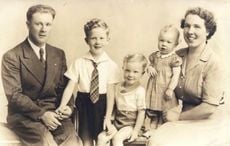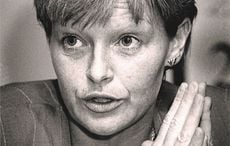| Captain William Burke |
During a service at St. Patrick’s Cathedral, Edward Cardinal Egan noted that Burke had "a good relationship" with his six brothers and sisters.
Ten years later, Burke’s brother is doing battle with a powerful government agency over an issue which was also important to Captain Burke -- art.
This battle comes just as the city mourns the loss of another firefighter, Lieutenant Richard Nappi, who died from heat exhaustion at a Brooklyn fire.
This also comes as a TV special this week reintroduced us to a truly sick woman, Tania Head, who rose to prominence as a high-profile 9/11 survivor, only to have her story exposed as a sham and a fraud.
All the more reason to take seriously the legacy of those who truly sacrificed on 9/11.
It is well known, by now, that the Freedom Tower is rising fast and furious at the former Ground Zero site. The 9/11 Memorial also opened to the public to great fanfare last year.
But there are still artifacts of 9/11 downtown, artifacts untouched by new construction and not located behind a glass wall.
Look no further than Battery Park at the southern tip of Manhattan. The vast waterfront park is a cherished green space amidst the concrete jungle, and also one of the most historically significant spots in downtown Manhattan.
Among other things, it is the former site of the Castle Clinton immigration depot, which is where vast numbers of Famine Irish arrived in New York, a good 50 years before Annie Moore arrived from Ireland on January 1, 1892.
Not far from a remaining Castle Clinton structure, near the Bowling Green subway station in Battery
Park, is a true work of art -- Fritz Koenig’s 25-foot Sphere, which had originally been placed in the plaza between the North and South Towers of the World Trade Center. The structure had originally been commissioned for that site, where it was placed in the early 1970s.
What is fascinating today about Koenig’s Sphere is that it survived the attacks with minimal damage.
Six months after 9/11, the Sphere was placed just south of Ground Zero – along with an eternal flame – in Battery Park.
To this day, the battered bronze work of art is a major tourist attraction, and seems so vastly out of place in the park that it seems…well, absolutely a perfect fit for the park.
True, even at the time, it was believed the placement in Battery Park would be temporary. And now, it appears as if the Port Authority is ready to move the Sphere to a site with not quite as much history as Battery Park: a hangar at JFK International Airport.
Here’s where Captain William Burke’s family comes in. His brother Michael started a petition objecting to the move, which by now has gotten over 7,000 signatures.
“Why not return it to where it was? Where it was a symbol of world peace for 30 years. Where it survived the attacks that took place and was embraced as an icon of the resiliency, the perseverance, the strength of America and peace and cooperation?” Burke told CBS Radio.
Personally, I think the Sphere should stay where it is: in Battery Park. Part of the beauty of New York is the city’s ability to adapt and bend without breaking, its utterly improvisational nature.
The Koenig sculpture works in Battery Park precisely because it was not designed to fit there. Awful circumstances forced its relocation there, and its placement – and the visible damage, and its eternal flame – is an authentic reminder of that terrible day.
But if the Sphere must be moved, Burke and his supporters are absolutely right.
Port Authority executives have argued that they might place the Sphere at a new park, Liberty Plaza, south of the former Trade Center site. Others have suggested there’s no room in the memorial for the Sphere.
But if you’re going to move this authentic survivor of 9/11, why would you shoehorn it into as-yet unopened park? Especially when it has found such a poignant home in Battery Park.
Michael Burke is right. If you are going to move the Sphere, it should go back to its old home.
(Contact Sidewalks at [email protected] or facebook.com/tomdeignan)




Comments